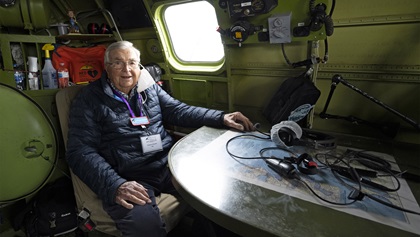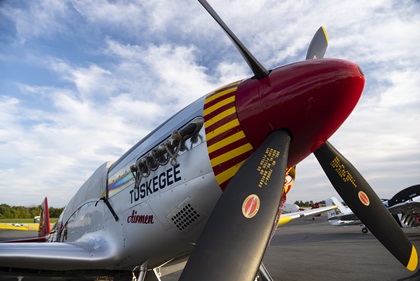2020 does it again: Arsenal of Democracy flight scrubbed for weather
Low ceilings snuff second, final attempt
If 2020 has taught us anything, it’s that we can’t have nice things. No airshows, no EAA AirVenture, and the latest casualty—the Arsenal of Democracy 75th World War II Victory Commemoration Flyover that was to have launched 70 warbirds into the skies over Virginia and Washington, D.C., on September 25, with a second and final chance to overfly the National Mall on September 26.
This time Mother Nature joined forces with 2020 to deliver an ironic sucker punch: several days of dazzling fall weather to give the airplanes time to assemble and practice for the formation, only to have ground crews and pilots disappointed as the morning fog cleared and then made a reappearance in the form of IFR conditions over the Potomac River, an important part of the flight’s route over downtown Washington, D.C. The flight was intended to commemorate the seventy-fifth anniversary of the end of World War II and was pushed to September 26, only to have low ceilings persist, forcing the difficult decision to cancel the commemoration.
“We are disappointed that we could not deliver the planned aerial tribute that our World War II veterans and heroes deserve for their selfless service to our nation and the world," the committee said in a statement. "We are, however, pleased to offer the special programming commemorating the end of World War II with never-before-seen footage of many of the aircraft scheduled to participate in the Arsenal of Democracy flyover, exciting footage from the practice flights that took place this week and a thought provoking interview that took place last night with Tuskegee Airman Brigadier General Charles McGee with the Smithsonian National Air and Space Museum."
The committee said the "tough call" was made in the interest of safety and security of the many pilots, volunteers, and others who orchestrated the logistical feat.
“We are thankful for all the local, state and federal support that we received in the planning and postponements of the flyover," the committee continued. "They wanted to see the flyover tribute executed just as much as we did. Unfortunately, given all the planning, preparations and organization, including meeting the extensive security criteria that go into such a massive event, there are no plans to reschedule this year. We are grateful for the generosity of our sponsors and all the hard work that was put forth to honor the sacrifices of America’s Greatest Generation.”
The air boss held out as long as he could before breaking the news of the first postponement on September 25. Formations of Boeing Stearmans had already departed to begin assembling their formations when the word went out, and they had to return. Honorary Air Boss Retired U.S. Air Force Lt. Col. Bob Vaucher, who led more than 500 Boeing B–29 Superfortresses over Tokyo Bay during the signing of the Japanese surrender, was already strapped into the navigator position of the B–29 Doc. Eight North American T–6 Texans had just started, the oil in the rumbling Pratt & Whitney engines barely getting a chance to warm up.
“We didn’t even get a chance to fly,” David Steele, pilot of N5451E, lamented good-naturedly. Steele, of Glen Allen, Virginia, practices formation flying regularly with some other local T–6 pilots and had been looking forward to participating in such a large-scale event. He’s owned the 1949 T–6G since 2017 but has been a warbird enthusiast for years. He grew up in a flying family, soloed in a Piper J–3 Cub, and is now a first officer for United Airlines.

“It’s the biggest warbird I could afford,” Steele said of the bright-yellow T–6.
At the September 25 flight briefing, Arsenal of Democracy Air Boss Mike Ginter praised the group for its practice run on September 24. “The practice flight yesterday was letter perfect, outstanding job, you all made it perfect,” he told the assembled pilots and crew.
The warbird community turned out in full force for the Arsenal of Democracy. Pilots and crew in green and khaki flight suits greeted each other as familiar names—FiFi, Champaign Gal—could be spotted on jackets and hats. Warbirds came to the staging airports in northern Virginia from as far as California and Texas, including the B–29 FiFi, owned by the Commemorative Air Force. FiFi Crewmember Curt Lewis had been looking forward to flying the formation—in a Twin Beech, as he does not yet have formation training for the bomber. An airline pilot, Lewis said his company had originally planned to furlough him on October 1, but that has been pushed to November 1. He said he’s not too concerned for himself, but more for his colleagues who have “mortgages and babies.”
Second attempt
Arsenal of Democracy flyover organizers had hoped to launch the aerial assembly on September 26. Waves of aircraft—from slower liaison and training models to faster bombers and transports—were still in position to fly over the National Mall, grouped according to their assigned military roles. More than 20 different types of military aircraft were ready to participate in the ceremonial flyover, which was rescheduled from May 8, Victory in Europe Day, because of the coronavirus pandemic.
A separate but smaller remembrance in Pearl Harbor, Hawaii, occurred between August 29 and September 2.
While low ceilings prevented the flights on September 26, organizers proceeded with portions of the plan, including the streaming programming, much of which was prepared in advance. Interviews with veterans and footage of many of the rare aircraft, such as Piper L–4 Grasshoppers, Stinson L–5 Sentinels, a Consolidated PBY Catalina, and a Consolidated PB4Y-2 Privateer, that were to have led five classes of military aircraft down the Potomac River was set to begin streaming at 10 a.m., even if the actual airplanes could not fly the plan. A procession down the river with a left-hand bank at the Lincoln Memorial would have taken the groups over the Mall at 11:30 a.m. spaced by two-minute intervals. The flight plan included a missing man formation to honor those who died in battle, exiting with a right-hand turn near the U.S. Capitol.
A squadron of training aircraft comprised the largest class of warbirds that assembled for the tribute, with eight Boeing Stearmans, eight North American T–6 Texans, five North American T–6 SNJ U.S. Navy variants, three North American T–6 Harvards, a de Havilland Tiger Moth, and a Fairchild PT–19.
The only two flying B–29s—Fifi and Doc—were in position to anchor a wing of strategic weapons that was to include five Grumman TBM Avengers, four North American B–25 Mitchells, a Boeing B–17, a Douglas A–26 Invader, and a de Havilland Mosquito. Several Douglas C–47 Skytrain transports had been slated to pull up the rear including That’s All, Brother, which led the D-Day invasion over Normandy, France.
 A formation of five North American P–51 Mustang long-range fighters paying tribute to the red-tailed aircraft of the Tuskegee Airmen were prepared to fly cover for the bombers, just as fighters did 75 years prior. The escort detail was to have been joined by two Grumman FM–2 Wildcats, two Vought F4U Corsairs, two Curtiss P–40 Warhawks, a Supermarine Spitfire, a Grumman F8F Bearcat, a Hawker Hurricane, a rare Fairey Firefly, and an even more rare Bell P–39 Airacrobra.
A formation of five North American P–51 Mustang long-range fighters paying tribute to the red-tailed aircraft of the Tuskegee Airmen were prepared to fly cover for the bombers, just as fighters did 75 years prior. The escort detail was to have been joined by two Grumman FM–2 Wildcats, two Vought F4U Corsairs, two Curtiss P–40 Warhawks, a Supermarine Spitfire, a Grumman F8F Bearcat, a Hawker Hurricane, a rare Fairey Firefly, and an even more rare Bell P–39 Airacrobra.
The waves of military power were orchestrated to commemorate D-Day, the Battle of Britain, the Battle of the Atlantic, the Battle of Midway, the Battle of the Bulge, the Guadalcanal campaign, the Doolittle Raid, the Chichi Jima incident, the Big Week, the Hump, Iwo Jima, Berlin, Pearl Harbor, and the Final Act that signaled the war’s end. The Civil Air Patrol, which formed in 1941 and transitioned to U.S. Air Force auxiliary search-and-rescue missions, was also to have been represented.
Preserving history
Many of the historic aircraft were provided by organizations and individuals whose mission is to preserve the artifacts in flying condition.
 Boeing B–17G Sentimental Journey pilot Pete Scholl and first officer Brian Churchill supervised as crew members readied the Flying Fortress for flight. Scholl complimented the B–17 as “a gentleman’s airplane” but stressed that power management is “critical.” The aircraft is powered by four Curtiss-Wright 1,200-horsepower radial engines that burn 200 gallons of fuel—and four gallons of oil—per hour, and costs between $3,000 and $3,500 per flight hour.
Boeing B–17G Sentimental Journey pilot Pete Scholl and first officer Brian Churchill supervised as crew members readied the Flying Fortress for flight. Scholl complimented the B–17 as “a gentleman’s airplane” but stressed that power management is “critical.” The aircraft is powered by four Curtiss-Wright 1,200-horsepower radial engines that burn 200 gallons of fuel—and four gallons of oil—per hour, and costs between $3,000 and $3,500 per flight hour.
On September 23, North American B–25 Devil Dog pilot Mark Frederick and first officer Beth Jenkins deftly handled the tricycle-gear Mitchell bomber as it rumbled down the runway for a practice flight. Aluminum skin and metal ribs bucked and creaked in a symphony of sounds before a formation of four North American T–6 Texans led by Veterans Airlift Command CEO Walt Fricke bore down on their tail for a photo mission during the “golden hour” before sunset. Farmland passed under their wings and the Appalachian Mountains came into view as other pilots formed up nearby in twos, threes, fours, and fives during practice for the Arsenal of Democracy flyover.
Author and pilot Kathryn “KT” Budde-Jones, who flies a North American T–6 Texan with her husband, Syd, watched as pilots and crew gathered near the warbirds, arranging their chairs to make new friends and renew old acquaintances. “We haven’t seen anything like this in about a year,” she said of the social opportunity.










